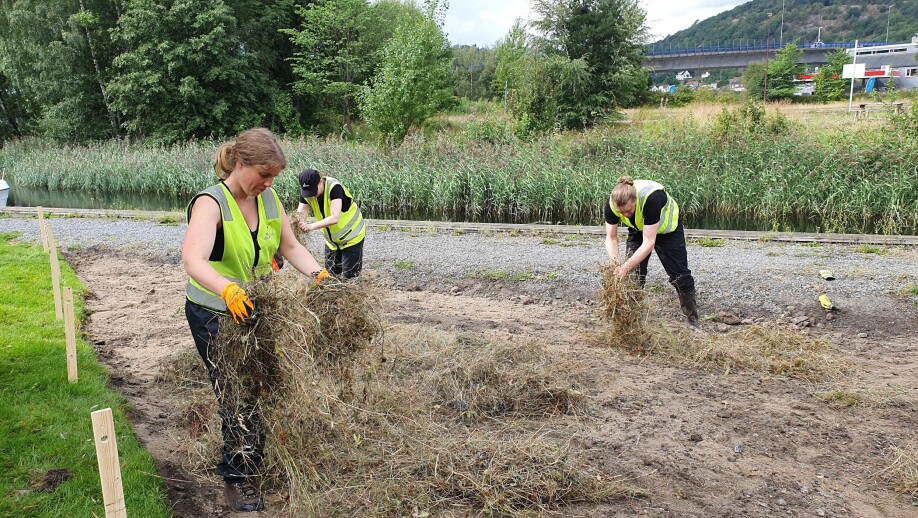THIS ARTICLE/PRESS RELEASE IS PAID FOR AND PRESENTED BY NINA - Norwegian Institute for Nature Research - read more

New use of traditional hay meadows is a win-win for pollinating insects and people
When the seed-rich hay from traditional Norwegian hay meadows is put to use to grow flower meadows in urban areas, both pollinators and people win.
Recently, the EU Commission presented A New Deal for Pollinators in response to the alarming loss of wild pollinators in Europe. This revision of the 2018 Pollinators Initiative aims to reverse the decline of pollinators by 2030.
It may seem ambitious to turn the trend around in the next seven years, but if we don’t succeed, the continued loss of pollinators will have huge consequences for our food security, ecosystems’ functioning and their biodiversity.
Pollinators play an important role for much of the food you have on your dinner table, but they are also essential for wild plants and all the wildlife—big and small—that depend on those plants.
Why are pollinators in decline?
“Changes in land use and intensification of agriculture are some of the main drivers of this loss. Pollinators need flowers and nesting sites, and that these resources are abundant and well-connected in the landscape,” Dr. Markus Sydenham says.
He leads several projects within the Norwegian Institute for Nature Research’s (NINA’s) Pollinator research group.

Critically endangered hay meadows
In Norway, hay meadows (slåttemark) were traditionally managed for animal fodder and were common in the agricultural landscape. Each farm would have had some sections of low-fertility land that was used as a slåttemark. Over time, the continued removal of grass for fodder meant that flowering plants could grow with less competition from grasses.
These hay meadows had a very high diversity of flowers and were a valuable resource for pollinators.
Early in the 20th century, agricultural intensification favoured the use of fertilisers and grasses to increase production. Hay meadows ceased to be an integrated part of the farmland economy. Because of this, hay meadows were often abandoned or converted. Nowadays, hay meadows are typically small, isolated, and are classified as a critically endangered nature type.

A win for both pollinators and people
“At NINA, we are exploring methods for both restoring these meadows and creating additional pollinator habitats,” Dr. Megan Nowell, who leads the FlowerMeds project, says.
Meadows need to be harvested in the late summer. Landowners receive subsidies for conservation-oriented management of hay meadows but often have trouble getting rid of the hay after it is harvested, and it ends up getting dumped or burnt.
“In the FlowerMeds project, we are developing a method for using this seed-rich hay to grow new flower meadows in other locations, like urban parks. If farmers can sell hay to landscapers who wish to create new meadows in urban areas, or if hay can be used for establishing flower strips along field edges as part of agri-environment schemes, then perhaps the traditional management of hay meadows can find its way back into the economy of the farmland,” Nowell says.
The use of such nature-based solutions to recreate species-rich hay meadows has multiple benefits for biodiversity and society. FlowerMeds will provide a knowledge base for local authorities, land managers and the public to implement and scale up these solutions.

What measures are most effective for pollinators?
In addition to restoring habitats in agricultural landscapes and enhancing pollinator habitats in urban areas, NINA is also addressing the EU Pollinators Initiative through better conservation of species and habitats.
Markus Sydenham’s research works towards identifying where in the landscape conservation measures will be most effective for pollinators.
“In the MetaComNet project we are developing methods for producing maps showing where the pollination potential for wild plants is particularly high, and where conservation action should be directed to preserve this ecosystem function,” Sydenham explains. “Meanwhile, the POLLILAND project aimed at prioritising where semi-natural grassland habitat restoration would be most effective for conserving pollinators."
Research is also ongoing to improve our understanding of the influence of managed bees on wild bees, understand the contribution of wild and native bees to crop pollination, and to improve our understanding of how land use and climatic conditions affect interactions between wild plants and pollinators.
“By studying pollinators from several angles, combining a broad spectrum of expertise ranging from ecology to genetics and ecological economics, and cooperating closely with stakeholders, managers and other research institutes in and outside Norway, we hope to contribute to reaching the bold goal of the EU Commision’s Pollinator plan, and turn the pollinators' situation around by 2030,” says Sydenham.

This article/press release is paid for and presented by NINA - Norwegian Institute for Nature Research
This content is created by NINA's communication staff, who use this platform to communicate science and share results from research with the public. NINA is one of more than 80 owners of ScienceNorway.no. Read more here.
See more content from NINA:
-
How will climate change affect lakes worldwide?
-
White-tailed sea eagles are breeding in Ireland again after more than a century
-
Could a tunnel help wild reindeer in Norway?
-
Norwegian white-tailed sea eagles are helping to rebuild a lost population in Ireland
-
1 in 4 freshwater species are at risk of extinction: "It's not too late to take action"
-
Insects prefer cold winters with lots of snow




































